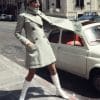Fashion is always about what’s new, but for an exclusive week HarpersBAZAAR.my is considering the old—all things vintage to be exact. Follow our first #BAZAARVintageView digital series for a treasure hunt for vintage clothes, vintage bags, vintage wares, vintage shoes and beyond, from the contributors who know it best. To premiere our series, Cherie Federau, founder of world-renowned Shrimpton Couture, shares her list of the most sought-after vintage designers.
The vintage market is incredibly vigorous at the moment, with no signs of slowing down. If a piece is really good, in museum quality condition, an early or pivotal example of a designer’s career and has the potential to be worn, it sells and sells fast. Part of the reason vintage is so appealing, and remains so, is that it is truly a finite supply. Perhaps 30 or more years ago, only the eccentric and occasional collector would actively hunt down pieces—but now there is great demand and competition to acquire pieces and that demand is of a global scale. I see no signs of it stopping. Even when you see things that seem expensive, they are still cheap compared to their modern equivalents and in comparison to what their worth will eventually be. The expensive pieces are an investment and one that will only increase in value, while the lesser expensive pieces are bargains and are an amazing value for your money. The golden rule is that if you see and you love it, you buy it—you may never get the chance again!
It is incredibly hard to pin down only ten designers to watch for, as a dealer my list is 4 or 5 times that amount and I know there will be an outcry as to who I have left off the list. But these ten are special to me. I also urge you to never underestimate the power of the anonymous piece. A label certainly and firmly places a dress in its place in history—but always look for great fabrics, craft and workmanship and pieces that really stand out and feel modern or unique.
#1. Yves Saint Laurent
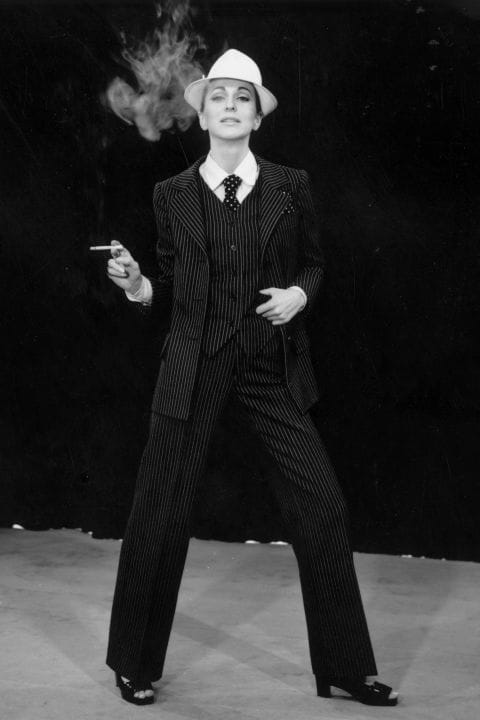
Image: Getty
Yves will always be collectible. His work only seems to acquire more beauty and to become more special as time passes. He made clothes that women not only wanted to wear, but needed to wear—that was the cult of Yves Saint Laurent. The longer time passes from when a particular piece was originally made, the more relevant that silhouette seems to become—it’s like magic. Almost anything designed by him over the course of his career is collectible. To him we owe the le smoking jacket, the trapeze dress and the jumpsuit. Particularly important to watch for are his iconic safari pieces and also his beautiful taffeta and silk gowns as well as his silk ball gown skirts – each done with great success for many of his various collections. I particularly adore the pieces made in the late 1970s and early eighties. Though harder to find, I would never pass up any Haute Couture item I can find as they are truly his great legacy.
#2. James Galanos
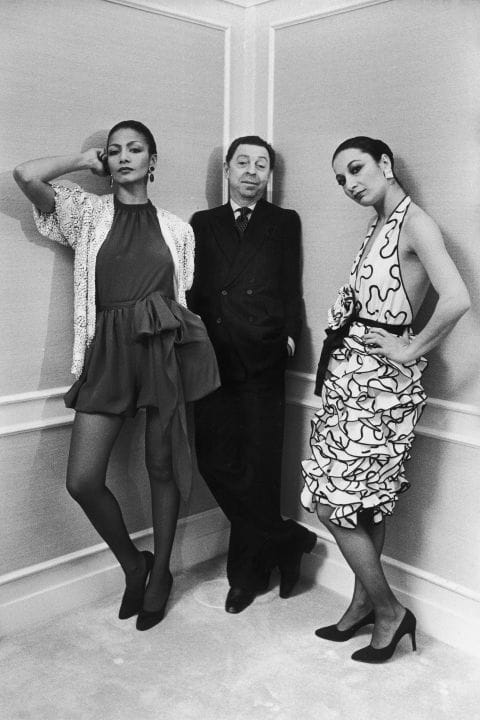
Image: Getty
Though not a name the every day person might know, amongst vintage connoisseurs his work is highly coveted. American designer James Galanos was the United States’ answer to European snobbery towards their neighbors across the pond. Galanos made couture-level gowns with a level of craftsmanship that left France’s most esteemed couturiers with their mouths agape. The immaculate construction of Galanos’ gowns oozed luxury, privilege, and high society (with price points to match). I never pass on a silk gown or long bias cut chiffon dress by him and for day his structured suits are magic. Embellished pieces are of particular importance and the workmanship divine. His pieces will only continue to increase in value and I have heard rumors of an upcoming museum retrospective on his work, which will only add to the demand for pieces.
#3. Christian Dior
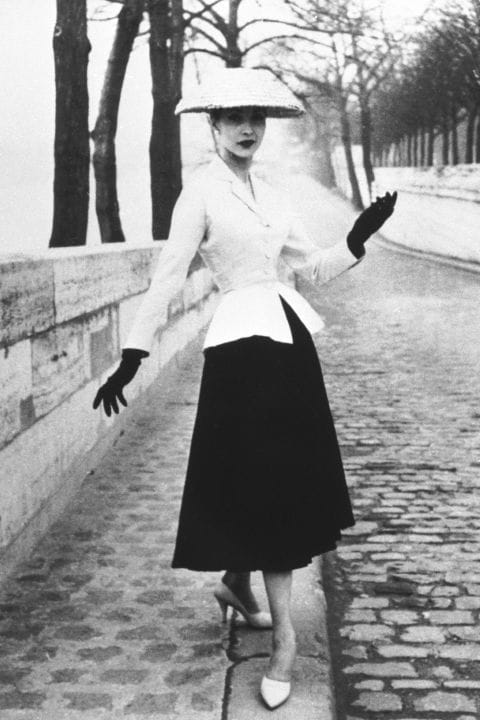
Image: Getty
The impact Dior has had on fashion knows no bounds and original pieces by Monseiur Dior himself are never to be passed down. In 1946 he established his maison and immediately made tremendous waves in the fashion world. The “new look” silhouette is as classic a shape as one can get in vintage and has been endlessly reinterpreted. Of course, it is that very sense of timelessness that the look has and still inspires which makes the originals so very important. Original couture versions can cost the price of a small car but you can still find good bargains if you are lucky to find the non-couture Dior London or Dior New York labels of the era. With the death of Mr. Dior in 1957, the house was in chaos until a young Yves Saint Laurent was placed at the helm. His rise to importance in his own right and short time heading the house make pieces designed by him for Dior even harder to acquire and so are always on my “Holy Grail” list, as are the chiffon gowns by Marc Bohan from Christian Dior from the late 60s to the early eighties.
#4. Thea Porter

Image: Thea Porter
When one thinks of the great British designers of the sixties and seventies it is most often Ossie Clark or Biba who come to mind. The recent, and first, exhibit of the work of Thea Porter at the Fashion and textile Museum in London this last year changed that. Since that successful exhibit Thea Porter has gained a broader audience. I have always loved and collected Thea myself and I am proud to say that Shrimpton Couture was invited by curator Laura McLaws Helms to have a portion of our Thea Porter archives featured in both the exhibit and accompanying book. A long admirer of Arabic fashion and textiles, Thea Porter interpreted the airy and ornate styles of her homeland into modern and updated designs that appealed to clients for both their exoticism and their comfort. Thea was a lover of intricate and embellished ornamentation and rich fabrics. Her clothes reflected this romantic nostalgia she had for all kinds of dress, be them Eastern or Western. Thea’s caftans in particular have no compare and are extremely desirable and collectible. They combine the exoticism and glamour of Talitha Getty with the masterful construction of the finest couturier.
#5. The Japanese Avant Garde
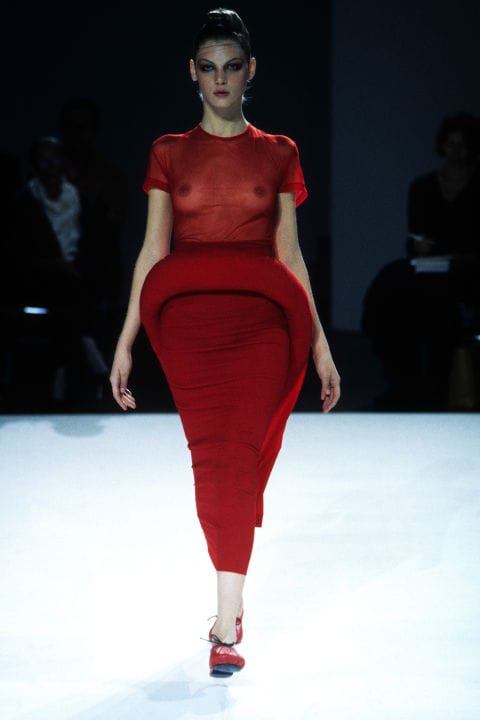
Image: Comme Des Garçons
Newer on the vintage scene and perhaps not technically “vintage’ are the Japanese designers whose avant grade work is just beginning to attract huge prices at auction in the past couple of years. Early or runway Yohji Yamamoto, Issey Miyake, Junya Watanabe and Comme des Garçons are four of the top names to look for. If this look is what you love, don’t wait for them to become officially old enough to be truly “vintage,” but rather, buy them now. Their current quasi-vintage status means you can still come across incredible bargains but that is changing fast. These are labels that are highly collectible and in demand right now and doing some prior research so that you can spot documented runway pieces will serve you well. In the East especially, the movement to collect these designers now is so strong that rare pieces can fetch prices well into the tens of thousands of dollars. Look for the boldest, craziest, most complicated designs you can find and throw the idea of wearability out the window.
#6. Paco Rabanne
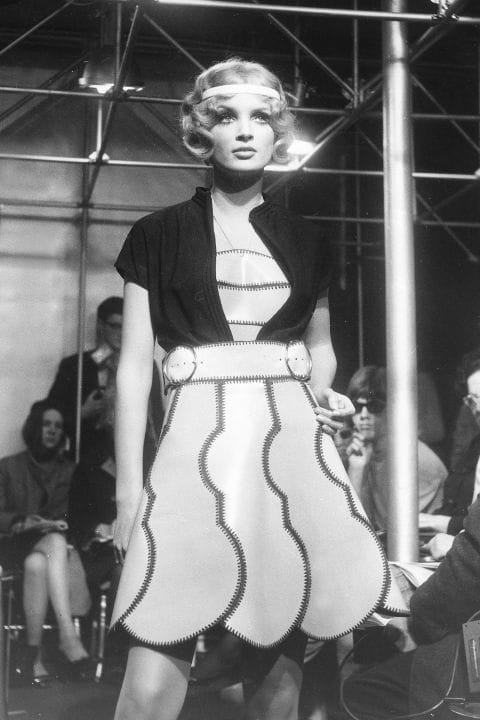
Image: Getty
Paco Rabanne was one of the designers that changed the way fashion was viewed by the entire world. The tone was set with his very first runway show in 1966, with a collection he called “Twelve Unwearable Dresses in Contemporary Materials.” His work is often referred to as “futuristic armour” and his influence extends to today. “I used strange materials, that’s how I stood out from others” Rabanne stated. This love of turning non-fashion materials into high fashion formed the very basis of everything that is now collectible by Rabanne. Look for the early pieces made of metal discs, Rhodoid plastic, joined with metal rings, paper, leather and rubber. The ultimate find is of course his signature chainmail technique dresses and tunics. You can find early plastic disc, cross body bags for decent prices to get an instant fix but it is the chainmail pieces that are the true collectibles. Be prepared to pay a pretty penny for couture pieces and then to not regret a penny of it after.
#7. George Halley
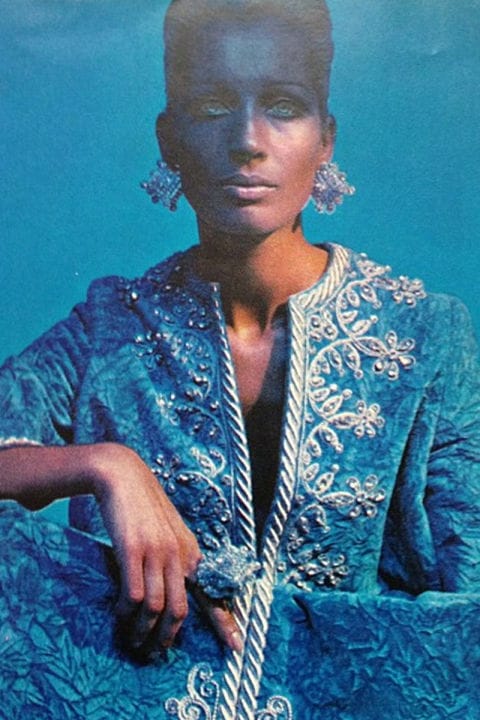
If you want old school glamour and to feel like Hollywood royalty, look to this under-the-radar label outside of vintage circles, that is also one of my personal favorites. A Coty Award winner in 1968, Halley was one of the great American Couturiers and his work always feels grand and elegant. Think polished silk and fused velvets and embellishments that have a touch of the Grand Old South to them. Silhouettes to look for are his sweeping ball gowns and hostess gowns. Rich fabrics and rich colors are used with a master’s hand. Feathers, crystals, hand painted fabrics and fine workmanship are all things to expect from a George Halley gown. Slipping one on instantly makes a girl feel special and important. These are the showpieces and while you should expect to pay for the quality and beauty of what you get they are absolute jewels. I suspect that his works will only gain importance as time goes by and if I heard of an exhibit being planned one day soon I would not be surprised.
#8. Pierre Balmain

Image: Balmain
Founded in 1945, the couture house has endured and appealed universally to glamorous women the world over, from royalty to Hollywood starlets. Balmain’s style became was known as “Jolie Madame” for his ability to encapsulate both vivacity as well as insouciant elegance in his designs. Pierre Balmain once said, “Good fashion is evolution, not revolution.” The quintessential French house has been worn by some of the most beautiful and endearing woman of all time—Audrey Hepburn, Ava Gardner, Brigitte Bardot, Josephine Baker, Katherine Hepburn, Marlene Dietrich and Sophia Loren all were clients and fans of the house. From chic day suits to the most glamorous and sweeping evening gowns dripping with crystals, Balmain is infinitely collectible. Early pieces are hard to find and you will pay dearly if you do find them. Similarly the most striking gowns are hoarded and rarely come to market so if you luck upon one, pay what you must and then thank your lucky stars.
#9. Emilio Pucci
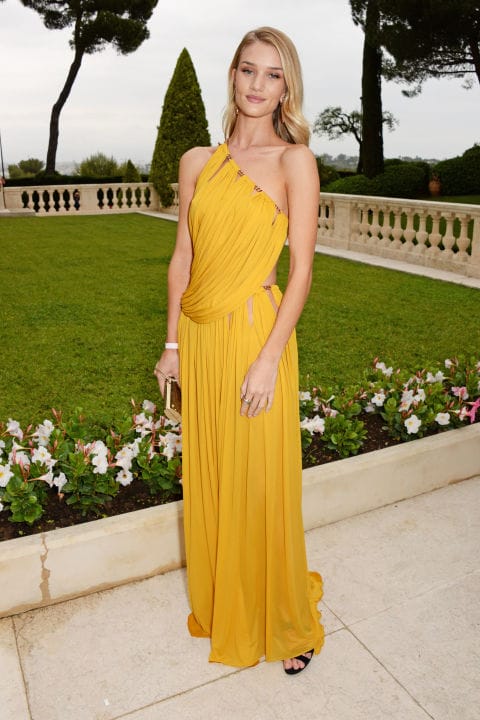
Image: Getty
The famous Pucci print is so taken for granted in our modern world that the actual workmanship behind them is sadly forgotten. For each collection Emilio Pucci hand drew the famous print with each rendition signed “Emilio”. The vividness and shocking kaleidoscope of color combinations were made possible by the constant pushing and cajoling to the chemical and textile manufacturers to develop methods to transfer and retain that vividness of color to the fabrics of his choice. This is why you can still marvel over how bright and fresh a vintage Pucci dress feels now despite that fact that it could have been made 60 years ago. The brighter the color the more collectible it is. Velvets seems to wane and wax in the market but the silk jerseys always command attention and I personally love the silk chiffon gowns and jumpsuits. On a more modern note, I think the collections Peter Dundas has done during his short time at Pucci are the strongest of all the designers who have tried to carry the house since Emilio passed away in 1992. Runway pieces and the well-documented celebrity and red carpet worn dresses in particular will be highly collectible in the future so would buy them now and tuck away.
#10. Oscar de la Renta
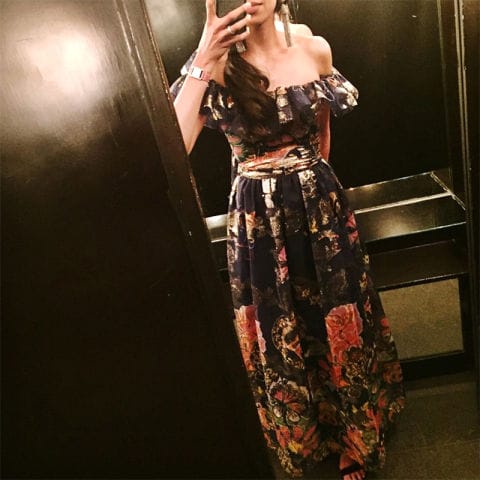
Image: Dana Ana Al Khalifa
Unfortunately in vintage the passing of one of the great living designers does see a fervor happen over the pieces from that designer. In the world of vintage we have seen this happen with Alexander McQueen over the last few years, his important pieces now can command many thousands of dollars. Prices sky rocket and early pieces become particularly desirable as collectors and museums realize that an era has ended and the ability to acquire examples has become that much more finite. Oscar de la Renta is the gold standard for universal elegance. Since 1965 with the launch of his own house, Oscar de la Renta has made his name in creating modern romantic fashions for the world’s most elegant women. You can find beautiful pieces spanning over the full 49 years of his career. I particularly love his very early Boutique pieces. For me they hold all the secrets of every collection he made after. There is also the added appeal of knowing that at the time his operations were still small and intimate so he would have seen and held every dress produced; overseen every detail. And that is magical.
For more on #BAZAARVintageView


